Chapter 1. Children at Play
Synopsis
Children at Play
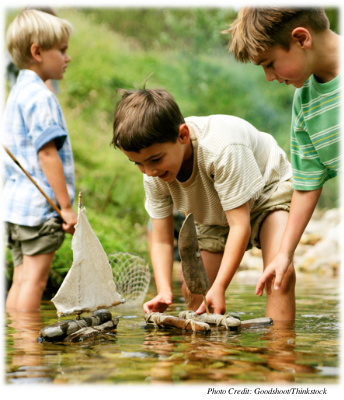
Authors
Lisa Huffman, Ball State University
S. Stavros Valenti, Hofstra University
Synopsis
This activity explores the various types of play, explanations for why children play, and the role of play in child development. To test your mastery, you will be asked to classify the types of play that you observe in several video clips.
REFERENCES
Berger, K. S. (2011). The Developing Person Through the Life Span (8th ed.). New York: Worth Publishers.
Pellegrini, A. D., & Smith, P. K. (1998). Physical activity play: The nature and function of a neglected aspect of play. Child Development, 69, 577–598.
Rubin, K. H., Fein, G. G., and Vanderberg, B. (1983). Play. In E. M. Hetherington (Ed.), Handbook of child psychology: Vol. 4. Socialization, personality, and social development (pp. 693–744). New York: Wiley.
Introduction
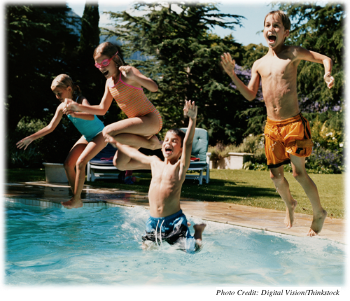
We often view children’s play as sweet or amusing to watch but with no specific purpose. What if someone told you about a preschooler who does not play? How would you react? A child who does not play is highly unusual because we know that healthy children should play, but why do we think that? Why do children play? Developmentalists have considered this question for decades, and researchers have discovered that play serves many purposes in child development.
Types of Play
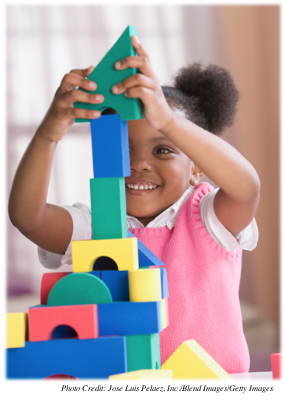
Researchers have long analyzed children’s quality of play rather than quantity of play and have grouped their play into the following categories.
Functional play is exploration of objects that allows infants and children to learn what they can do with objects and what objects can do. Functional play includes simple repetitive actions, such as blowing a whistle, bouncing a ball, or throwing bean‐bags. This type of play improves children’s motor and coordination skills.
Physical play involves repetitive muscular activities that are physically vigorous. This play includes running, jumping, and rough‐and‐tumble play. Like functional play, physical play improves children’s motor and coordination skills. Physical play is most common among 3 and 4 year olds and is generally more common among boys than among girls. Physical play tends to decline somewhat during the middle childhood years.
Constructive play is activity in which children make or build something. It is common among children ages 3 to 6. Communication skills tend to improve through play with others, especially in constructive play.
Types of Play (continued)
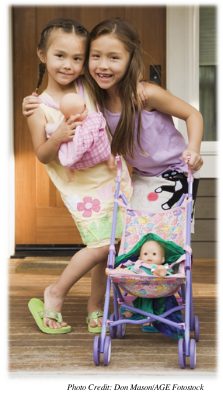
Fantasy or pretend play consists of activities in which children pretend to be someone or somewhere else and act out schemes, such as being mother to a doll, being a locomotive engineer, or being a particular cartoon character, superhero, or athlete. Acting out situations and role‐playing improves children’s social and emotional understanding. Fantasy play is common among children from infancy and turns into collaborative pretend play at about age 4. Interestingly, girls are more likely to engage in this type of play than boys are.
Play involving rules includes participation in sports and board games. Playing such games requires a child to take another person’s perspective, which is an important component of both social and cognitive functioning. For example, children cannot play kickball successfully if they do not understand that each player has his/her own view of the field and that each player has a different responsibility on the team. Play involving rules is most common during middle childhood years.
Children at Play: Observation 1
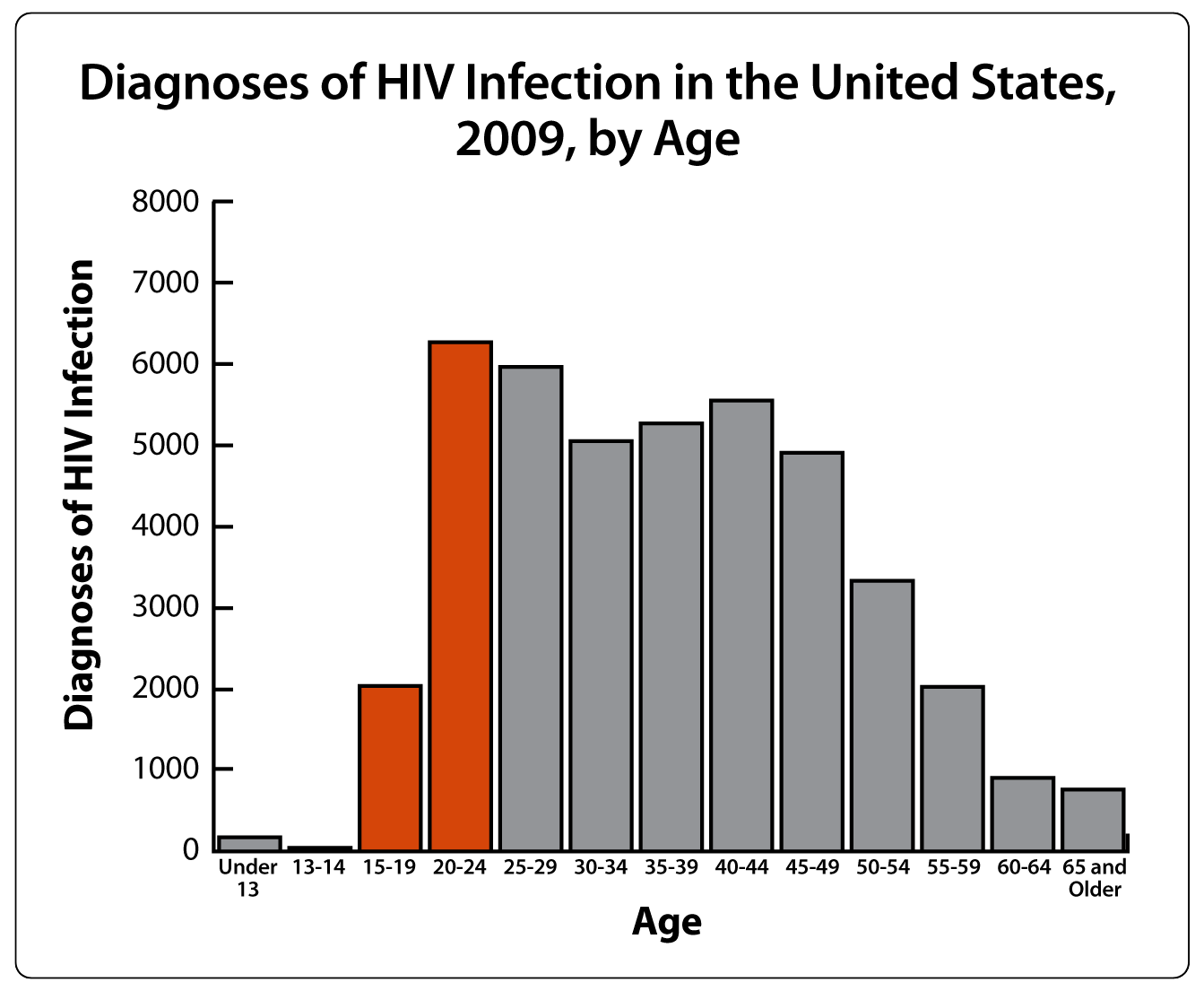
You are about to see some videos of children playing. After you view the video on each screen, identify the type of play that you have observed based on the categories described on the previous two screens.
Question 1.1
41Ub7uS16Fl6bnQflrRt88LJnQN71FJYgCusbsUKWtIonP5br6Php6PDN0egoFIOscDZGW9/Q3jSwEMTrjObvQ/ar45abFWwxGj+IYDqNDk1sQ+zWifbJjTs0IdvcCtzYH/mhtT3KkAn9jpWbiHXA4RlF+N+5KnRx/nh6K5pPdFZ28ThVyp6vCZWRNtnGsMIkPkRbO0+5MtwmvxRpxq621a0lMepmUXSTDBWSRcO+LZKK+G3jczj59q9FXQCYH0dChildren at Play: Observation 2

Question 1.2
PCiYxjJK7GBr2mJIguo4j8DOU07/acGpzixN2IGYMHEOyUT5pubb+xqwTRQEc8XZI19YCYhoj43VDkWUMZCfeFUVEdDYlpEYVqZwlO5glKlJLpB0pJ7ys0LcshOSFyo+F9usR0qZ4hFgjfAxOnS0tJJt/rmk+J2cLZrWQV63oBIEDC4XdH2uPftxwBjqjsR/PZoyMRhT3usuShKLPaBxQAgxjY+F5modjWGYy2H2XOGjtVe/D68b13oiDK4SYeO1Children at Play: Observation 3

Question 1.3
dxUykCVFpUb+HhffWV3HK34UoQK3dudmgzaR+eny/rebn7OxHzMFWV4nSgvM90dzhAuy5VMqOswKqZ/FtmGYGQMvcdymm01p7LR0vXzLCAhM0jQ6DURI2dwK7RgmeVimdEcym+slgs8gwAEByPlMm4gFkUcWveZU3Avb+DPGbc6R3ALc6Sr1JgfOquMExEdcbUTA2jAtaGx4+1AxiUv0dbRfjqoru2hECrX/Ku/K2Fr48ghyETJni019qDk+oIqyChildren at Play: Observation 4

Question 1.4
vgMP99nOOgKLCb8S9DNqZEGGaguxNzwllpnIYedgPncLcCCFao4cnQrcBhFs45mkEQNP5AEhg77cuJvo0O9h7oFignVyYZEM5yAvfVSPdMup0Mt1W2AtCfN9DfS59t1FK1u8ytZWfDo3fWNyDTbB2BOXy7SuujrINhMvECkGebOvZynOhUGK7QnYOudY7FtbxePaJfTFw+moxrKZyqwNXnMhjW8ooo4QfJKbDXXlnY637ChnsnIf1fFCIqJ1hT4BChildren at Play: Observation 5

Question 1.5
C1FEyN4ZO9igvmnURpiG456uy6PyzXY7CQZBceWE42ho1pfVGSut8iOgXD67sW3MHUYlij7nNensGbk2VfQvdoSl2r4AMM5fLOBgMwAE+G6G0QaxuCLtABr2mJxf7B/lns1KeSGiI8H1TX77U1mV2S7oFgUXdcpRU65J3T9jALJREYQyoeex6bHd6/TiOHjcdDqYQFyUlvkt31cbcP/v8OlC+ylcA40UKKH+bitRihmlqhONzFgy7lwzgeW9XagFChildren at Play: Observation 6

Question 1.6
wUNwuDzSf3Igh5SY7kwpoe+KmkF56khbpI4gxy8WiBP3fTGKuLLpkf9IsFxhvIbes6v2NaLjBIsdOQAxaM7gCSNhWYtQUAHwARBrsOoYOyCoE7pRp7zbbxygmvI1fA6mMNY9QxKID4H7LIVvmwxH4C2Yb1yLNE/wIKMX3fs4RG8p0uQiZ2xWL3hLaTOW0VjfnIpVSUX9mCdtkWdd0TJf43iAqz9htnXcrNdsDvXy2CNhgY9bzqzSDwceyjjH3OPWThe Purpose of Play

Although play may seem recreational, you now know that play is children’s work. It has many functions in children’s development. No matter what play they engage in, children are always learning. They develop physical, emotional, cognitive, and social skills through play. While playing, children are practicing how to use their growing bodies and minds.
Much current research focuses on the role of gender and culture in play. While play is universal, it varies across gender. Boys and girls tend to play differently. While children prefer to play with peers of their same gender, it is not at all unusual for children to play in mixed‐gender groups. It does depend on what playmates are available! In general, boys are more likely to engage in rough‐and‐tumble play, which is aggressive activity with no intent on hurting play partners. In contrast, girls are more likely to engage in fantasy or dramatic play, which provides opportunities for learning about social roles, regulation of emotions, and communication.
Play is evident in every culture. Make‐believe play is fairly universal across the globe as children try‐on and practice roles that they observe in their own communities. Therefore, the specific details and types of fantasy and dramatic play distinctly vary from culture to culture. The rough‐and‐tumble play that is characteristic of many boys is seen in most cultures around the world. The style and nature of this play also varies according to the customs and behaviors of the particular society.
Assessment: Check Your Understanding

Question 1.7
71axeB14FfWaat0szh0cKOItsw0KPg7Y/7I0OCacDk4xpW/XVDixT3N/1C+ITxJwzI0cD/Qa7Q9C/AsUKHHHVHUhdwk=Assessment: Check Your Understanding

Question 1.8
UvdSzsd8NVSQmP2e0fe6obl4qE+PCYwlDWvD7XrU05W7yzhEjYe9Sf9fycDtRIzI3hol0wV0iHd+bsa/YdmXmKBR2xUUW9udd/R7iY80AaEitcAsXs3oVfRfY5IpwWgMzxbpYPLhXnN2Jo0BAssessment: Check Your Understanding

Question 1.9
xTcHgUpNp4XGgQVQDzZbDt/s58/l4unOZgfU23HS5h3U6L5uYjytG6Ws2AZohDxyZ9uMIoM06kVY0+38e3Wxagv3JMZORvBbGq2AqzhzO5CdJ1rXUn8MyJjIRqivfXPdu5xfU1af+Aew2icwUDqF8679oKc18P8YCongratulations! You have completed this activity.Total Score: x out of x points (x%) You have received a provisional score for your essay answers, which have been submitted to your instructor.